ikfoundation.org
The IK Foundation
Promoting Natural & Cultural History
Since 1988


 Crowdfunding Campaign
Crowdfunding Campaignkeep knowledge open, connected, and growing on this textile history resource...
TEXTILE OBSERVATIONS ON ICELAND IN 1772
– A Case Study of Uno von Troil’s Life and Journeys
Weaving of homespun, collecting of eiderdown, trade in wool and cloth or observations of local clothing are not subjects that the court chaplain and later archbishop Uno von Troil (1746-1803) usually are associated with. However, as a young man on a journey to Iceland, he made enlightening and detailed notes in his travel journal on such traditions. A few words about his early life lead up to these events. His father was ennobled in 1756, which gave the family and the ten-year-old Uno extended privileges. Already the following year at the age of eleven, he became a student at Uppsala University, which was not entirely unusual for boys from well-to-do families, but first in 1770, he finalised his studies in mainly history and theology. After his exams, travels and further studies on the Continent took place, and when arriving in London in 1772, he met the naturalists Daniel Solander and Joseph Banks – during a time when the latter was leading the preparations for a scientific voyage to Iceland.
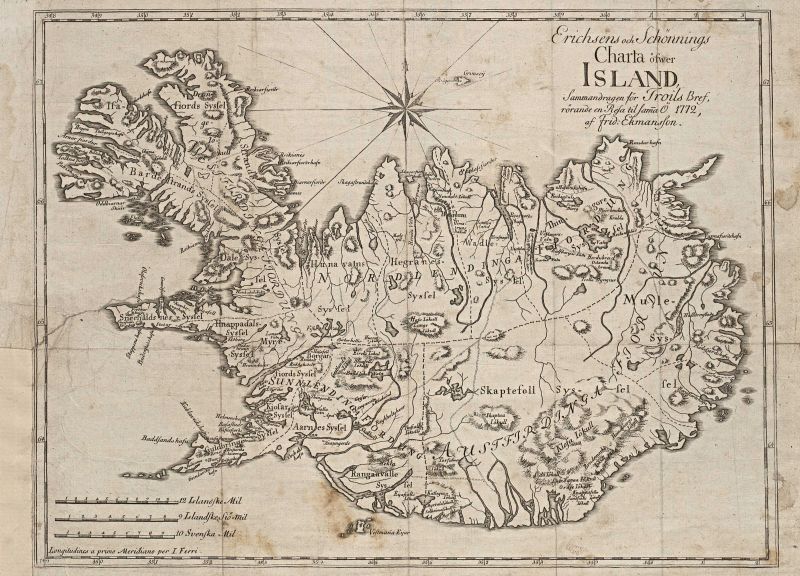 The large-size foldable Iceland map, included in Uno von Troil’s Swedish edition of his travel journal ‘Bref rörande en resa till Island’, published in 1777. (Illustration: Troil, Uno von, Bref rörande en resa till Island. Uppsala 1777, p. 1).
The large-size foldable Iceland map, included in Uno von Troil’s Swedish edition of his travel journal ‘Bref rörande en resa till Island’, published in 1777. (Illustration: Troil, Uno von, Bref rörande en resa till Island. Uppsala 1777, p. 1).One aim of the Enlightenment period was “to observe everything” on a journey, and Uno von Troil was one of many young scholars who followed these ideas. He seems to have had a general interest in natural history, humanitarian matters, and local traditions, as well as specialist knowledge of languages, history, philosophy, and theology. His initial period abroad – 1770 to 1772 – included visits and regular attendance at lectures at several universities as well as network-building with learned men, particularly in Göttingen. At his arrival in France, he came in contact with the Enlightenment philosophers Jean-Jacques Rousseau (1712-1778) and Denis Diderot (1713-1784), among others in Paris. The glimpse into the world of these well-known men – more than thirty years his senior – may have influenced him in many ways. To have met Diderot for instance, at the time for his ongoing editing of the Encyclopédie must have been an inspiration for a young man like von Troil, who in the coming year got the possibility to amass facts from a wide range of subjects on the Iceland journey – including weaving, local clothes as well as trade in wool and eiderdown. In the smaller format, it almost became like an encyclopaedia of Icelandic traditions.
It is noticeable, too, that von Troil had no prior knowledge of the planned Iceland journey when arriving in London 1772, for the reason that Joseph Banks (1743-1820) had changed his travelling arrangements in short notice. James Cook (1728-1779) actually departed without him and found other botanists to explore the flora and fauna on his second voyage, which set sail in July 1772 – that is to say in the same month as the Iceland journey. Uno von Troil came to accompany the twelve-man crew – primarily invited due to his interest in the Icelandic language – on an expedition led by the naturalist Joseph Banks. The voyagers set out from Gravesend on 12th July 1772, almost exactly a year to the day after the naturalists Daniel Solander (1733-1782) and Joseph Banks had returned from their circumnavigation with James Cook, which lasted from 1768 to 1771. The ship rounded Dover and sailed towards the Isle of Wight, Plymouth, Cape Cornwall and northwards to Scotland, where local people were visited and botanical excursions undertaken.
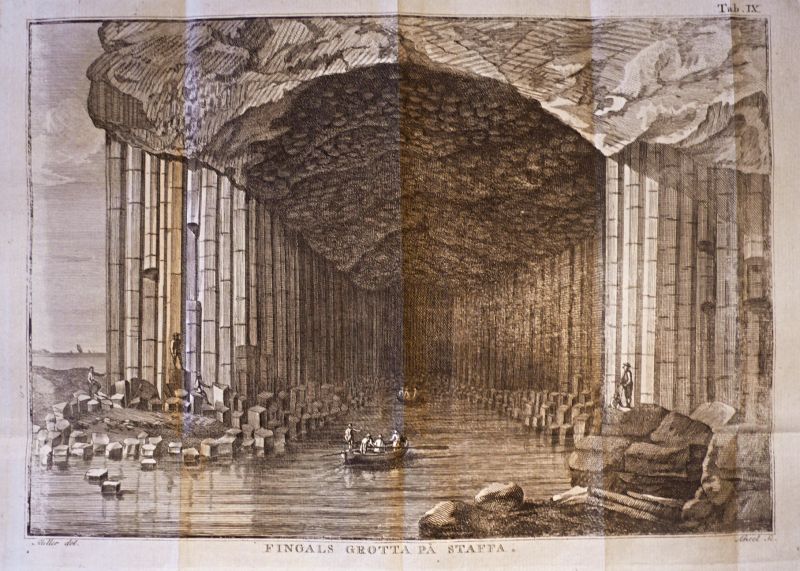 The trials and hardships the travellers’ clothes had to withstand during the round trip of Scotland and Iceland can be seen in this illustration, ‘Fingal’s Cave on Staffa’, the island to the west of the Isle of Mull. It is possible that the travelling gentlemen during their visit, late summer and autumn of 1772, each acquired a sturdy woollen coat which protected their other clothes; furthermore, woollen fabrics are unrivalled in dirty, damp and cold environments. (Illustration: Troil, Uno von, Bref rörande en resa till Island. Uppsala 1777, p. 281, Tab. IX).
The trials and hardships the travellers’ clothes had to withstand during the round trip of Scotland and Iceland can be seen in this illustration, ‘Fingal’s Cave on Staffa’, the island to the west of the Isle of Mull. It is possible that the travelling gentlemen during their visit, late summer and autumn of 1772, each acquired a sturdy woollen coat which protected their other clothes; furthermore, woollen fabrics are unrivalled in dirty, damp and cold environments. (Illustration: Troil, Uno von, Bref rörande en resa till Island. Uppsala 1777, p. 281, Tab. IX). 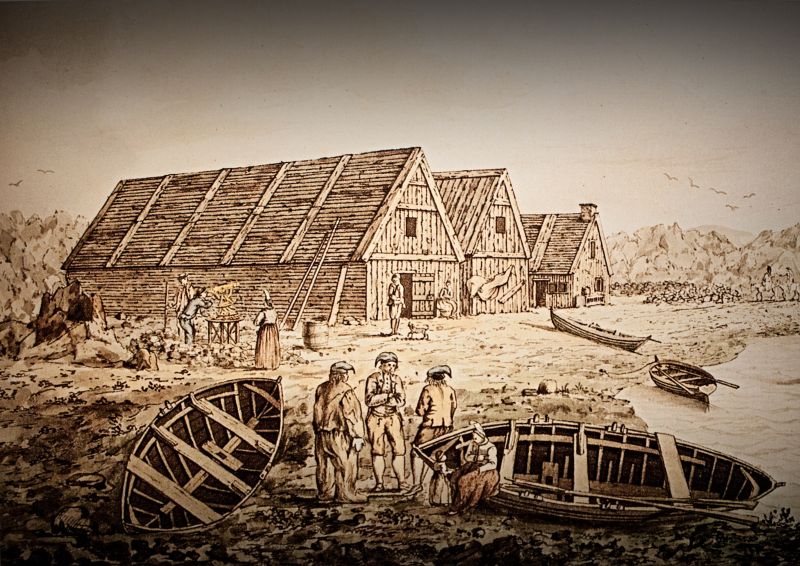 On 16th August the ship headed further north from Oransay in the Hebrides for Iceland and twelve days later reached its destination Hafnarfjörður harbour where they anchored on 29th August 1772. The group stayed for six weeks on the island, where most of the time was devoted to Hafnarfjörður, botanical and geological field work and visits to the volcano Hekla. This informative watercolour, made by one of the accompanying artists on the journey, John Cleveley the Younger (1747-1786), gives a detailed view from several perspectives. In particular traditional clothes worn by men, women and a small child alike – added with exact drawings of rowing boats and houses in this coastal community, together with ongoing scientific observations. Furthermore, according to research by Anna Agnarsdóttir, this was the Danish merchant houses in Hafnarfjörður, a place where Joseph Banks, Uno von Troil et al. stayed during the Iceland visit. (Collection: Reykjavík Maritime Museum, Iceland. Part of original image: Wikimedia Commons).
On 16th August the ship headed further north from Oransay in the Hebrides for Iceland and twelve days later reached its destination Hafnarfjörður harbour where they anchored on 29th August 1772. The group stayed for six weeks on the island, where most of the time was devoted to Hafnarfjörður, botanical and geological field work and visits to the volcano Hekla. This informative watercolour, made by one of the accompanying artists on the journey, John Cleveley the Younger (1747-1786), gives a detailed view from several perspectives. In particular traditional clothes worn by men, women and a small child alike – added with exact drawings of rowing boats and houses in this coastal community, together with ongoing scientific observations. Furthermore, according to research by Anna Agnarsdóttir, this was the Danish merchant houses in Hafnarfjörður, a place where Joseph Banks, Uno von Troil et al. stayed during the Iceland visit. (Collection: Reykjavík Maritime Museum, Iceland. Part of original image: Wikimedia Commons).
Subjects of a textile nature, mentioned by Banks and von Troil in their writings, dealt with the important handling of wool, the weaving of homespun or wadmal, the collecting of eiderdown, trade in wool, cloth and down, besides notes on the Icelanders’ clothing. Iceland was an island where the population had been severely decimated during the 18th century due to volcanic eruptions, earthquakes, unusually cold winters, famine and disease, leaving deep marks. What most surprised the group, therefore, seems to have been the bareness of the land and the inhabitants’ wretched lives. All the ash, which covered the island, also contributed to the people being of poorer health than in other places, and the island was also colder than expected. Due to the fact that the travellers only arrived in Iceland in September, a number of plants were past flowering and the remaining exemplars grew in Great Britain at higher altitudes. The surprises were but few.
The success of the expedition was limited, and the Icelandic journey, therefore, was not mentioned much in the 18th century. Uno von Troil’s documentation was the exception; however, due to that, he immortalised the journey in a number of letters which were published some years later. His account of life in Iceland clearly interested people at the time and translated into English, German, and French. On the other hand, Banks never published any discoveries made on the journey from his diary notes (first published 200 years later), but he did spread information about Iceland via the literature and old manuscripts he had brought back. He is on those grounds seen as having inspired the English and Scottish to travel north to the north of Scotland, the Hebrides, Orkney and other places to discover the northerly and sparsely populated parts of the island kingdom. Best known of them would be James Boswell (1740-1795) and Samuel Johnson (1709-1784) in 1773.
After arriving in Iceland, it was von Troil who took note of the sheep of the country and the weaving of cloth and wrote about the division of labour between men and women. The women worked the wool, did the sewing, spinning and collecting of down, while both men and women wove wadmal and were paid by the yard for their work. A woman ought to be able to weave three yards of this fabric in a day, which must have meant many hours of labour at an intense tempo. The wool used for the wadmal was moreover described as: ‘The principal profit they have from their sheep arises from the wool; this is not shorn off as among us, but remains on till the end of May, when it loosens of itself, and is stripped off at once like a skin, and is then called Ullafaell (wool shedding)’. During the ‘wool shedding’, new short wool was already growing and was seen to be of good quality. Shearing the sheep was avoided during the summer and autumn so as best to help the animals cope with the cold and wet winters. Additionally, he perceived the sheep’s wool as resembling camel hair and the main objective was for the sheep to produce great quantities of wool, preferably yields of four pounds in weight per annum.
Eiderdown, an extremely warming material for stuffing in bedding, was another valuable source of income for the Icelanders. The women collected the eiderdown mainly during the egg-laying season, when it was at its finest and most plentiful. An eider-duck could, according to von Troil’s observations, yield half a pound of eiderdown at that time of year, which was then sorted into two qualities: thaugduun and grasduun. The latter was considered the very best and was separated in the following manner: ‘... some yarn is streaked in a square compartment round a hoop, on which the down is laid. A pointed piece of wood is then moved backwards and forwards on the lower side of the yarn thus streaked, which causes the coarser feathers to fall through, while the fine down remains on the yarn’.
He drew attention to the development of the Icelandic trade in such essential goods as cloth, wool and eiderdown. Iceland was at the time under the Danish Crown and was so to remain until 1848; since the year 1734, there was, moreover, a trading company with the monopoly of trading, and for that privilege, a considerable sum was paid in tax to the Danish king. The company annually sent 24-30 ships to Iceland bringing grain, bread, wine, iron and wood as imports from/via Denmark in exchange for fish, pork, butter, skins, wool, eiderdown and woollen textiles. The export of eiderdown was the commodity principally recorded by von Troil. The material was sold ready cleaned, but also unclean at a lower price; it could even be plucked from dead eiders. However, that was regarded as markedly inferior, the eiderdown then having lost its elasticity. The export value of the eiderdown was therefore poor. The trading company nonetheless exported large quantities every year, both cleaned and unclean, weighing between 1,500 and 2,000 pounds, plus a minor private export of eiderdown carried by visitors for their own needs. That the value of that soft and warming stuffing material was financially critical for the trade is illustrated by the following figures: ‘In the year 1750, the Icelandic company sold as much in quantity of this article, as amounted to three thousand seven hundred and forty-five banco-dollars, besides what was sent directly to Glückstadt.’
The traveller also noticed that the Icelanders often had several minor buildings near their dwelling-house. The one most frequently seen of those was for keeping fish, but sometimes they owned a building set aside for the storage of clothes only. One home whose owner had such a storeroom for clothes clearly did possess considerable collections of clothes and other textiles. Similar clothes stores could be found in many farming homes in the Nordic area too, either in the form of an attic chamber, a box-room or a separate small building for storing the family’s valuable clothes and textiles.
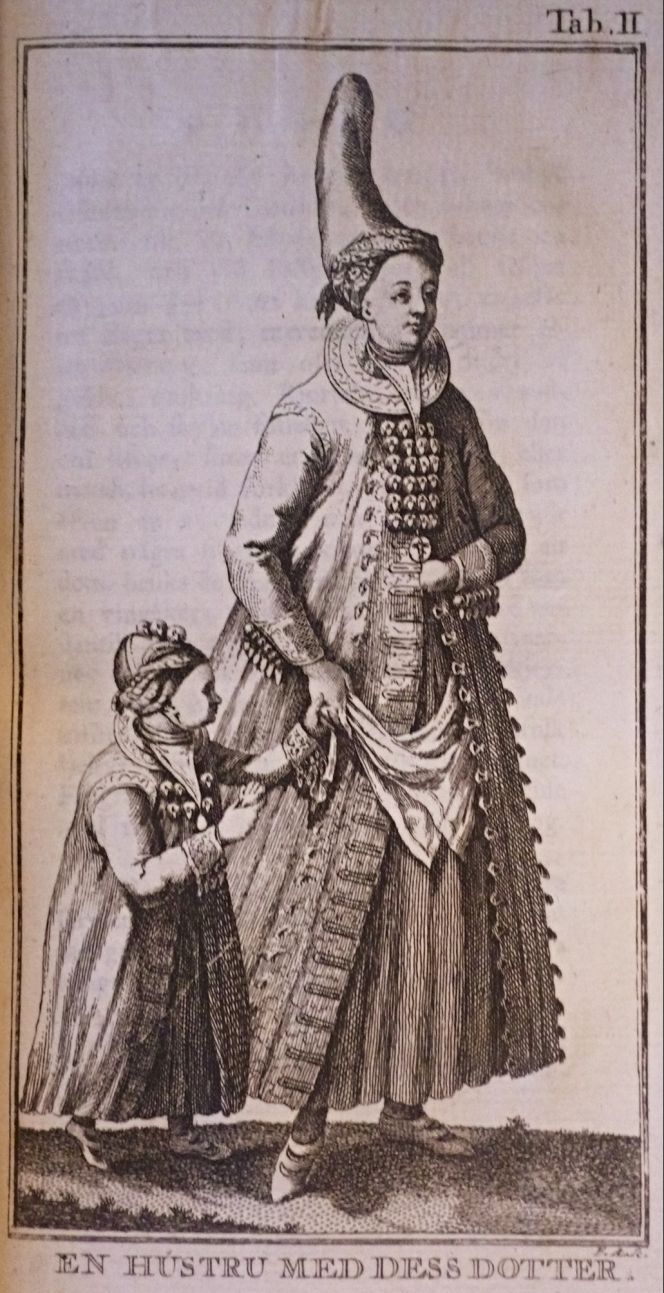 In Uno von Troil’s letters from the Icelandic tour, the woman’s dress was described as follows by the traveller: ‘Their head-dress consists of several cloths wrapped round the head, almost as high again as the face; it is tied fast with a handkerchief, and serves more for warmth than ornament: girls are not allowed to wear this head-dress before they are marriageable.’ Mother and daughter are seen dressed almost identically with the exception of the married woman’s headdress. (Illustration: Troil, Uno von, Bref rörande en resa till Island. Uppsala 1777, p. 72, Tab. II).
In Uno von Troil’s letters from the Icelandic tour, the woman’s dress was described as follows by the traveller: ‘Their head-dress consists of several cloths wrapped round the head, almost as high again as the face; it is tied fast with a handkerchief, and serves more for warmth than ornament: girls are not allowed to wear this head-dress before they are marriageable.’ Mother and daughter are seen dressed almost identically with the exception of the married woman’s headdress. (Illustration: Troil, Uno von, Bref rörande en resa till Island. Uppsala 1777, p. 72, Tab. II). To be compared with that Joseph Banks let John Cleveley the Younger – one of the three artists on the expedition – make this beautiful ‘Drawing of an Icelandic woman in her bridal dress’. This hand-coloured drawing shows the wealthy woman’s traditional costume during their visit in 1772, with a rich selection of gold jewellery, including a long chain around the neck with a cross-style pendant, the traditional head-dress, a large-size handkerchief and a red apron. (Courtesy: British Library, London. Drawings from Sir Joseph Banks’ Voyage to the Hebrides, Orkneys, and Iceland. No: Add. 15512, No.17. Wikimedia Commons).
To be compared with that Joseph Banks let John Cleveley the Younger – one of the three artists on the expedition – make this beautiful ‘Drawing of an Icelandic woman in her bridal dress’. This hand-coloured drawing shows the wealthy woman’s traditional costume during their visit in 1772, with a rich selection of gold jewellery, including a long chain around the neck with a cross-style pendant, the traditional head-dress, a large-size handkerchief and a red apron. (Courtesy: British Library, London. Drawings from Sir Joseph Banks’ Voyage to the Hebrides, Orkneys, and Iceland. No: Add. 15512, No.17. Wikimedia Commons).Overall, Uno von Troil wrote a lengthy account of the look and function of the Icelanders’ everyday clothes, which he perceived as short on variety. In contrast to the festive dress illustrated above, he regarded the dress as lacking in elegance, but was carefully made and well suited to the climate. The black wadmal was the predominant cloth in both men’s and women’s clothing, warm and hard-wearing. The men’s dress consisted of a short jacket and a pair of wide trousers of this coarse cloth, while a linen shirt was worn next to the skin; on their feet, they wore worsted stockings, probably knitted, and on the head, a three-cornered hat. The women’s wadmal dress was made in the shape of a frock-like garment reaching to the ankles, added to which was a jacket often decorated with silk or velvet ribbons. On top of that was worn a coat of wadmal, somewhat shorter than the dress, called hempa.
On departing from Iceland, the ship set sails for the Orkney Islands, where the group arrived on 16th October. The sea voyage then continued to Edinburgh, where they stayed for a few days before finishing the journey overland to London, where they arrived on either 19th or 20th November. The trip to Iceland and northern Scotland lasted just over four months. The botanical discoveries may have been few, but the journey brought insight into the sparsely populated Scotland and, above all, the Icelanders’ tough living conditions. There, the textiles were of immense importance: to ameliorate the cold, make life more comfortable and provide crucial income through the extensive export of woollen cloth and wool.
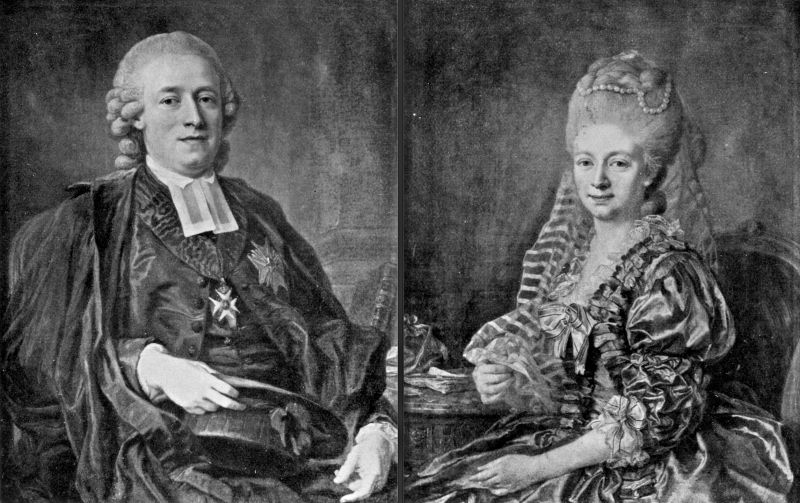 When arriving home from his circa three year-long Grand Tour-cum-studies and the Icelandic voyage, Uno von Troil was ordained priest in 1773 and a few years later he married Magdalena Elisabet (née Tersmeden, 1753-1794). These two portraits, painted by the well-renowned artist Lorens Pasch the Younger (1733-1805), show the couple slightly facing each other. Judging by the lady’s fashionable garments etc, the depictions were probably made around the time of their marriage in 1776 or not later than in 1778. Judging by these portraits and other known biographical sources, the couple had a very comfortable or even wealthy lifestyle, both belonging to noble families in Sweden and during the coming years Uno von Troil was appointed Bishop in 1780 and six years later Archbishop. Depending on the stages in his career, the couple lived in the cathedral cities of Linköping and Uppsala, together with their large family, which increased in size to ten children over the years – all except one daughter lived to adulthood. (From: Holmgren… 1925, two separate portraits).
When arriving home from his circa three year-long Grand Tour-cum-studies and the Icelandic voyage, Uno von Troil was ordained priest in 1773 and a few years later he married Magdalena Elisabet (née Tersmeden, 1753-1794). These two portraits, painted by the well-renowned artist Lorens Pasch the Younger (1733-1805), show the couple slightly facing each other. Judging by the lady’s fashionable garments etc, the depictions were probably made around the time of their marriage in 1776 or not later than in 1778. Judging by these portraits and other known biographical sources, the couple had a very comfortable or even wealthy lifestyle, both belonging to noble families in Sweden and during the coming years Uno von Troil was appointed Bishop in 1780 and six years later Archbishop. Depending on the stages in his career, the couple lived in the cathedral cities of Linköping and Uppsala, together with their large family, which increased in size to ten children over the years – all except one daughter lived to adulthood. (From: Holmgren… 1925, two separate portraits).In conclusion, a few letters from Uno von Troil to Joseph Banks about matters connected to their Iceland journey in 1772 are still extant, dating from 1773 to 1799. However, weaving of homespun, collecting of eiderdown, trade in wool or other Icelandic textile traditions – which the young Swede described with such great attention to detail in his travel description was not part of this infrequent correspondence over 26 years.
Sources:
- Agnarsdóttir, Anna, Ed., Sir Joseph Banks, Iceland and the North Atlantic 1772-1820, The Hakluyt Society, London 2016.
- Ahlberger, Pär, ‘An Apostle of Daniel Solander’, iLINNAEUS | iMagazine | iStories (November, 2021).
- Hansen, Lars, ed., The Explorer’s Field Guide – Bridge Builder Expeditions: | The Return of the Naturalists – Iceland. A scientific voyage to Iceland in 1772. Daniel Solander, Joseph Banks and Uno von Troil – Sweden, England, Scotland & Iceland, London & Reykjavik 2022.
- Hansen, Viveka, Textilia Linnaeana – Global 18th Century Textile Traditions & Trade, London 2017 (pp. 221-226).
- Holmgren, Ann Margret, Valda tidsbilder ur Amiral Carl Tersmedens memoarer, Stockholm 1925. (Portrait of Uno von Troil and his wife Magdalena Elisabeth, née Tersmeden).
- Nordisk Familjebok, Vol. 29, pp. 798-99 (Biographical facts about Uno von Troil), Stockholm 1919.
- Rauschenberg, Roy A, ‘The journals of Joseph Bank’s voyage up Great Britain’s west coast to Iceland and to the Orkney isles July to October 1772.’ Proceeding of the American Philosophical Society vol 117, no 3, 1973 pp. 186-225.
- The Genealogy Library, Online Geneanet (Search names: ‘Uno (Troilius) von Troil’ & ‘Magdalena Elisabet (Lona) Tersmeden’).
- Troil, Uno von, Bref rörande en resa till Island, Uppsala 1777.
- Troil, Uno von, ’Letters on Iceland’, Voyages and Travels in all parts of the World, ed. John Pinkerton, pp. 621- 734, London 1808.
More in Books & Art:
Essays
The iTEXTILIS is a division of The IK Workshop Society – a global and unique forum for all those interested in Natural & Cultural History.
Open Access Essays by Textile Historian Viveka Hansen
Textile historian Viveka Hansen offers a collection of open-access essays, published under Creative Commons licenses and freely available to all. These essays weave together her latest research, previously published monographs, and earlier projects dating back to the late 1980s. Some essays include rare archival material — originally published in other languages — now translated into English for the first time. These texts reveal little-known aspects of textile history, previously accessible mainly to audiences in Northern Europe. Hansen’s work spans a rich range of topics: the global textile trade, material culture, cloth manufacturing, fashion history, natural dyeing techniques, and the fascinating world of early travelling naturalists — notably the “Linnaean network” — all examined through a global historical lens.
Help secure the future of open access at iTEXTILIS essays! Your donation will keep knowledge open, connected, and growing on this textile history resource.
been copied to your clipboard




– a truly European organisation since 1988
Legal issues | Forget me | and much more...
You are welcome to use the information and knowledge from
The IK Workshop Society, as long as you follow a few simple rules.
LEARN MORE & I AGREE







